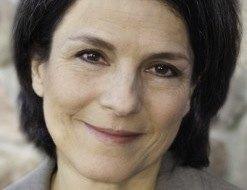Women in CSR: Nancy Cleveland, Resonate


Welcome to our series of interviews with leading female CSR practitioners where we are learning about what inspires these women and how they found their way to careers in sustainability. Read the rest of the series here.
TriplePundit: Briefly describe your role and responsibilities, and how many years you have been in the business.
Nancy Cleveland: My business partner Jennifer Anderson and I founded Resonate in 2010. We wanted to develop a sustainability management consultancy that helped companies focus on being strategic and using sustainability as a management tool to create long-lasting business value. My role and responsibilities range from client services to developing our technology products. I also serve as in-house legal counsel.
3p: How has the sustainability program evolved at your company?
NC: I had been doing sustainability work for several years before founding Resonate. When I started, I was a real estate lawyer, so my primary focus was on green building and LEED. It was clear to me from the start that companies could fairly easily build new buildings to green standards, but understanding and incorporating sustainability into their culture and way of operating a business requires more time and different tools and processes. So I shifted my focus from the built environment to general business consulting and co-founded Resonate. Resonate was founded on the premise that by being more strategic, companies will reap greater value from their sustainability efforts. However, this often requires a consultant’s perspective, especially for companies that are new to sustainability. For medium and smaller companies, consulting is often not an option. So, we started to think about how we could make strategic sustainability concepts more widely accessible through technology. We believe that technology and technology-assisted consulting can streamline and expedite a company’s journey toward strategic sustainability. It can make sustainability management feasible for many more companies.
Based on that belief, we began building Sustrana, which is short for Sustainability Strategy Navigator. We believe so strongly in the value of this technology – integrating sustainability tools and education into a single platform with roadmaps for what to do – that in the coming months we will merging Resonate into the Sustrana brand. The Sustrana platform will make sustainability planning and management available to companies who want to pursue this journey but can’t afford consulting or can only afford the light consulting that Sustrana makes possible.
3p: Tell us about someone (mentor, sponsor, friend, hero) who affected your sustainability journey, and how.
NC: My journey has been one that started with awareness and quickly evolved into action. There have been so many influences it’s really difficult to pick one. Many authors and speakers in this field have helped form my understanding and work in sustainability – Rachel Carson, Bill McDonough, Ray Anderson, Donella Meadows, Jeremy Rifkin – and others from related fields such as human psychology (like Malcolm Gladwell) or probability (like Nassim Nicholas Taleb). I’ll stop there because I already know I’m going to leave out too many fields and people.
One thing I will say is that working in sustainability and learning deeply about the challenges we face has taught me the importance of counter-balancing the bad news with inspiration and a focus on what’s possible. It has taught me to explain, but not dwell on the list of very difficult challenges we face; to spend more time on positive activities like helping people discover what solutions are possible for them to contribute. It has made me believe that individual people really can and do make a difference. In this regard, the stories in Chip and Dan Heat’s book Switch: How to Change Things When Change is Hard have been very inspirational because they are about the amazing things that committed individuals can do when they find and build on what’s positive and what is already working in the midst of a challenging situation.
3p: What is the best advice you have ever received?
NC: From my mother: Take one day at a time, do the best you can with every day you have, and when life seems overwhelming and daunting, try a good night sleep and see how things look in the morning.
3p: Can you share a recent accomplishment you are especially proud of?
NC: I’m extremely proud of the team we have put together at Resonate and our internship program. Working with our highly dedicated core team, and being able to inspire and be inspired by so many interns who are just coming into this work, is one of the greatest joys in my life.
3p: If you had the power to make one major change at your company or in your industry, what would it be?
NC: It would be to have the resources to accelerate our technology development so that we could get Sustrana to market sooner. Time is our biggest enemy in the work that must be done to make our world more sustainable.
3p: Describe your perfect day.
NC: My perfect day is really a day in the future when I am spending my entire day working with many, many more companies who are using Sustrana to set their paths toward a more sustainable future. It is a day when I realize that humans really can rise to the occasion and turn away from our current destructive path.
Is Networking a Dirty Word?


By Shannon Houde
Whenever I tell a client they need to network to land a career in sustainability, grown men and women screw up their faces like their little kid just said a forbidden word – the horror!
To many people, networking is a dirty, cringe-inducing word. The mere thought of standing alone at an event surrounded by potential employers, clients or contacts has them breaking out in a cold sweat. But these same people will happily go to a party or chat to a stranger on a plane, so how do they suddenly develop a phobia of meeting new people when they find themselves in a professional situation? They've forgotten that all networking is is basically making new friends, and that it can be fun as well as strategic, albeit takes practice.
Social media takes the pain out of modern networking -- there are no awkward silences on a LinkedIn profile even though you could send an InMail and never hear back – at least you get a refund. If you're looking to make a career move into sustainability, corporate responsibility or the green economy, in-person networking remains the best way to convert potential opportunities into real jobs.
After all, the main soft skill that crosses most roles in the sustainability agenda is communications – whether you are bridging the gaps between different stakeholder groups or influencing a Board for buy-in you need to be a great communicator, great connector and great relationship builder. Networking is just another aspect of that same skill set. For sustainability jobseekers, events and conferences are a great opportunity to show off those talents face-to-face, so step away from the coffee table and give yourself a professional edge by following my tips below:
1. Don't defer
Think everyone in the room is smarter, more senior, better dressed than you? Then you'll never have the courage to start a conversation. Banish the imaginary hierarchy in your head and place yourself on an equal footing with everyone else, equally deserving of respect, equally worth talking to. Stand with shoulders back and front of your body open to the room so that you are accessible and friendly looking while also looking confident.
2. Empathize, don't sympathize
There are other people in the room feeling just as awkward and uncomfortable as you are. Rather than feeling sorry for yourself, turn your attention outwards and look for someone just as lost as you to go and speak to. As Jeff Haden puts it, "Turn sympathy for yourself into empathy for another. Go rescue someone."
3. Be prepared
Having a little background knowledge on the other companies and individuals attending can be worth its weight in gold, so do your research in advance. At the same time, it's a good idea to prepare a 30-second elevator pitch that sums up your USP – unique selling points. A killer elevator pitch is concise, clear, confident, and ends with a question or request.
4. Ask great questions
This comes from being well informed with your research as in step three. If you already know something about the companies that are attending, you can confidently ask about the sustainability work they're undertaking. For example, you could ask how that new initiative is working out? What are their key issues? How is the process working? How are they approaching stakeholder engagement? Just like in dating, when in doubt, ask the other person to tell you about themselves and their work.
5. Be comfortable with silence
Confident people aren't fazed by gaps in the conversation so don't let your nervousness overload the person you're speaking to with a babbling monologue. Confidence is demonstrated as much in silence as in what you say. Better to pause and let the silence set in or allow it to be an opportunity to move on to someone else.
6. Follow up
A short 'nice to meet you' email in the days after a meeting isn't just polite, it will remind key contacts of who you are, what you do, and what you have in common. Sounds simple? You'd be surprised how few people actually do this. Rather than just sending out a generic LinkedIn invitation, make a personal connection - because that's what it's all about – building a relationship.
7. Give to receive
Once you've made that new connection, networking doesn't end there! All relationships are a two-way street so think about what you can offer as well as what you can receive. Nurture your network by sharing articles, insights and ideas. That way, when you need a personal recommendation or an internal referral, you're more likely to get a positive response.
For more insights on networking, career changes and making it in the competitive world of sustainability careers, contact me.
Shannon Houde is founder of Walk of Life Consulting, the first international career coaching business focused solely on the environmental, sustainability and corporate responsibility fields.
Op-Ed: Design Has to be Emotionally Durable


By Jon Turney
Any hilltop is enhanced by a wind turbine. The symmetry of the turning blades is as pleasing as knowing they are capturing energy and making it useable. So it seems to me, anyhow. But any discussion of wind power reminds you that plenty of folk find every wind farm a blot on the landscape.
This sharp difference of opinion is a reminder that aesthetics is a powerful influence on what we make, where we put it, and whether we like the results. Knowing that, how can we use aesthetics to enhance the appeal of sustainable design? It is a complicated challenge, because aesthetics is complex: a mix of visceral responses, culture and values that makes something look or feel ‘right.' Our consumer culture seems in thrall to the ephemeral, the disposable and the cute. Qualities like efficiency, durability and fitness for purpose appeal when we buy stuff, at least in theory, but it is easy to be seduced by novelty or surface sheen.
Even when a design is ‘green,' it may not be apparent. You can’t tell that a super-efficient hybrid car has miraculously low fossil fuel consumption by looking at it: it’s still a car. Reduced material or energy during manufacture is difficult to perceive. And in the past, environmentally friendly design that wore its heart on its sleeve has given some of it a reputation for aesthetic self-denial: not hair shirts for all, but close.
As Lance Hosey, author of the recent book "The Shape of Green," which explores aesthetics and ecology, puts it, “many consider great design and green design to be separate pursuits." He cites the celebrated buildings designed by Frank Gehry as an illustration. Their organic curves are undoubtedly beautiful, but they demand a lot more steel for construction than more conventional designs would.
It’s harder to appreciate the benefit of some environmentally worthy goods because they don’t win a lasting place in our affections. Jonathan Chapman, professor of Sustainable Design at the University of Brighton, argues that we must make things that are “emotionally durable." As he puts it, “Why are some things important to us, and not others? That’s a question any designer should be interested in, whether they care about the environment or not.” If we have possessions that we love, then there is sense in making them from long-lasting materials, easy to fix, and upgradeable. If they don’t have that appeal, then such efforts are wasted, because we toss them out as soon as they show signs of use.
One possibility here is to design products that develop in a way people might like as they age – such as that pair of boots so comfortable you take them to be re-soled year after year. A little imagination can extend this principle. One of the students on the Brighton course, Bethan Laura Wood, designed teacups whose inside glaze is treated so they stain in a geometric pattern with repeated use. The more tea you drink, the clearer the new decoration gets.
Rich Gilbert of The Agency of Design company makes a similar point, drawing on its extensive work exploring materials use, waste and recycling. He cites the design of a toaster made from sand-cast aluminium. It is a rough finish by contemporary standards. On the other hand, he reckons it will look much the same after 100 years use as after one or two. “Some materials age gracefully, gaining a patina, and we can celebrate that.”
He also makes it clear, though, that the aesthetic employed must depend on what you want to achieve. The company worked up two other toaster designs, one modular, and one designed for easy disassembly and recycling of the mainly plastic parts. Each might be a different route to eliminating waste from the product cycle. The household kettle, he says, demands the same treatment: he’s working on it.
The kitchen is often a focus for contemporary design. This can raise aesthetic barriers to doing one’s environmental duty. A detailed study of how people think about at-home recycling, 'Unpacking the Household,' carried out by Exeter University’s Stewart Barr for Coca-Cola Enterprises (CCE), found that recycling routines are strongly influenced by each domestic set-up. Since most houses pre-date regular recycling, a key question is where to collect and sort different types of waste. As the research summary puts it, “participants argued that more space is often needed … they aren’t prepared to compromise the aesthetics of their home to make room for a recycling bin."
So while manufacturers – and CCE is one – are making their product packaging recyclable, the benefits can remain elusive when the bottles and cans reach the home.
The good news is that knowing this highlights the scope for improvement. Recycling bins are ugly, but they don’t have to be. “We neglect aesthetics at our peril," says Dr Barr: “We’re not being very clever about how we design these things.” They exist in a culture where their contents are still seen as waste for disposal, and something we want to keep separate from our living (or cooking) space. “We want to move to where they are seen as ways of storing material which is on its way to re-use.”
Revising the designs would benefit from cocreation with users: what would we prefer our recycling bins to look like? And it needs to take account of the preferences of different household members. Kids are often the household recycling advocates, so child-friendly designs for the bins would probably help.
Away from household design, major building projects can allow architects to explore an aesthetic that expresses the value of a larger project. A current example is the proposal for the Offshore Visitor Centre for the £800 million Tidal Lagoon renewable energy scheme soon to be installed in Swansea Bay, South Wales. Paul Newman of Juice Architects explains that the building will be “a beacon for what sustainability represents." A series of overlapping shells, inspired by the local oysterfishing tradition, will create an eye-catching structure which resists the weather. As the building will be three kilometres from the shore, the shells will have to be made of concrete, but the forms will blend with the surroundings while drawing in a hoped-for 80,000 to 100,000 visitors a year who will learn about the massive engineering project below the water. The curves of the shells recall some of Gehry’s work, or the Sydney Opera House, but they have been simplified to allow a more straightforward concrete construction.
The rest of the building’s systems will embody the project objectives, too. “We’ve tried to make it self-sufficient”, says Newman. Lighting, ventilation and temperature control are all configured with that in mind, and as well as recycling waste energy from the adjoining turbine plant there will be solar panels on the roof and walls of the turbine gallery. The result should be a gallery space that incorporates a sustainable aesthetic in its own structure in a way that is as inspiring to visitors as the tidal power project it is designed to show off.
Cape Farewell (see Tear down the silos between art and science for a creative explosion) is also commissioning a major sculpture to be sited in or near the Swansea Bay Tidal Lagoon. The artwork, it specifies, should interact with the ambitions and significance of the lagoon. Such unity of aesthetics and values generates a kind of coherence that product designers and manufacturers need to strive for.
Photo credit: Courtesy Juice Architects/Bethan Laura Wood 2006
Based in the U.K., Jon Turney writes about science, design and tech.
Corporates waking up to need for greater tax transparency?


In contrast to Christian Aid's report earlier this week (see here), big businesses are becoming more transparent over their tax affairs, according to a new report from PwC.
Almost half (49) of the FTSE 100 now disclose information on their overall approach to tax, a 50% increase on 32 companies that explained their approach the previous year.
Andrew Packman, tax partner at PwC, said: “It's evident that companies are sharing more information about their tax affairs. Increased interest in tax and a desire to build trust with customers, employees and investors are undoubtedly encouraging voluntary tax disclosures.
“Whether we will soon see the majority of FTSE firms disclosing similar levels of detail on tax is uncertain. Tax transparency varies from industry to industry and some investors simply don't demand more information or are mindful of the costs involved. But all businesses should be considering these issues at board level and have an agreed approach to tax transparency. Interest in tax is not going to go away.”
The report also highlights that geographical reporting is now on the agenda of the UK's biggest companies, with a number of mandatory requirements already in place.
Some 22 FTSE100 firms (17 the previous year) now provide some breakdown of taxes around the world, either by region or by country. Eight of these firms are extractives companies, who experience particular interest in where they pay tax, and four are banks, who will soon have to communicate detailed figures as part of the CRDIV transparency requirements.
Picture credit: © Kelttt | Dreamstime.com
Got a Sustainable Business Plan in the Works? It Could be Worth $680,000


Ed note: This is a sponsored post on behalf of the Postcode Lottery Green Challenge
If you’re not familiar with the Dutch Postcode Lottery’s Green Challenge, you’ll be impressed to know that it’s among the largest and longest running sustainable business plan competitions in the world. The goal of the contest is to bring smart and innovative green products and services to the mass market and thereby help combat climate change. If you have a written business plan for a product or service that will reduce greenhouse gas emissions and a way to bring it to market within two years, then you’re an ideal candidate for the €500,000 grand prize (that’s $680,000).
But there’s a catch - the deadline is coming up quickly on June 3.
Now it its eighth year, the Postcode Lottery Green Challenge is open for sustainable startups from all over the world. Over the past seven years the Green Challenge has helped to advance numerous valuable, innovative green ideas -- you could be next. This year U.S. and global finalists are urged to submit their business plans, ranging from renewable energy innovations to breakthroughs in sustainable materials.
Need some inspiration? Learn from past years’ winners.
Ginger Dosier won last year’s prize. Her company bioMASON ‘grows’ bricks for use in building construction. American Molly Morse won the 2012 grand prize for Mango Materials, a company that uses bacteria to turn methane into biodegradable plastic. In 2010, Scot Frank won for his low-priced, multi-purpose portable solar collector Solsource. And back in 2008, Eben Bayer of the United States won for his natural insulation material @Mushroom Materials.
The Details:
To be eligible for the Green Challenge, a product or service must reduce greenhouse gas emissions and it should be possible to be in the market within two years. Entry is free of charge but requires a detailed business plan and elevator pitch. You have until midnight (central Europe time) on June 3 to complete your entry. (More details here).
The grand prize winner will receive €500,000 to help bring his or her plan to the market. An additional €200,000 ($272,000 USD) will go to one or two runners-up. The entries will be judged through an intensive deliberation by a renowned group of global jurors who will look for products and services that contribute to an eco-friendly lifestyle, directly reduce greenhouse gas emissions, and score highly on convenience, quality and design. The jury will select five to seven finalists in August which will be announced on www.greenchallenge.info, Twitter and Facebook and on September 11 each finalist will present their plans an event in Amsterdam.
The Power of the Consumer in Sustainable Fishing


For many of us, our connection with the global fishing industry is the local fish store or supermarket. For most of us, that amply stocked fish counter and frozen seafood section is our indicator of whether the ocean’s richest bounty is faring well. We may hear of the plight of one or another fleet of fishing vessels that, for some reason, has been short on its catch that season, but we are rarely burdened with the impact of that shortage. The selection of fish in the display case may change, but more often than not, the shelves appear to stay well stocked.
But take a stroll down the fishing docks of any major port, where just 30 to 40 years ago boats were brimming with their latest catch, and the impression is liable to be different. Fisheries are progressively being fished out, and at an alarming rate. As early as 2006, scientists predicted that global fisheries will collapse by 2048 unless we find ways to stop rampant overfishing.
Today, the news is even more specific: According to the Monterey Bay Aquarium Seafood Watch program, located in Monterey, Calif., 85 percent of fisheries around the world are already being fished to capacity, or are in the process of decline.
Species like the blue fin tuna, once prolific and popular, are rapidly reaching extinction. The grouper, orange roughy, some Chilean Sea Bass* and various abalones are either have been subject to overfishing as well.
What can the common consumer do? How can the average person who shops at that fish counter really have an influence on the actions and decisions of fishing vessels on the other side of the world?
The answer, says Ryan Bigelow, who serves as the outreach manager for Monterey Bay’s Seafood Watch program, isn’t simple. But consumers do have a direct input to changing global fishing patterns. And they do have a direct say into whether stores and restaurants stock sustainable seafood.
Overfishing and the consumer
The first step, he says, is to understand what overfishing really is. Sure, it’s essentially extending past the limits of what our waters can sustain, but the problem, or symptom, may not be limited to the single type of fish you like, or the particular region the fish comes from.
“[Overfishing] is taking too much [fish] or too much of a species, or too much of one piece out of one area.” Therefore, “you have to consider that species as a larger ecosystem. It is probably predator or prey for something else. It might be both. So when you take one piece of one string out of the web and pull it, it impacts across the entire system.”
An example is the over-abundant lobster population on the East Coast, Bigelow says, which scientists believe is flourishing beyond sustainability because a local predator -- cod -- has been overfished.
“And that sounds like a good thing, right? More lobster. But there’s so many lobster that the price has dropped so the market has crashed. So you have these unintended consequences of pulling on one species that other species rely upon, either as food again or as a species to keep them under control as a predator.”
Fishing the smaller fish stocks
The concept of simply turning to smaller fish down the food chain that haven’t been overfished can have mixed results as well. On one hand, Bigelow says, it makes sense to turn to smaller fish that may have been prey for that larger, now overfished species. Smaller fish often reproduce faster and in large numbers -- an added benefit in terms of commercial fishing.
But as scientists are finding, says Bigelow, “We don’t really know what the impacts are to the broader ecosystem when we start pulling [fish] out in the numbers we do. When you have a very small creature that is a necessary prey item for so many other species and when you start pulling them out of the water, we really can’t say for certain how fast those impacts will be [felt].” Scientists are only beginning to understand the vast web that makes up the marine ecosystem, and how to anticipate the impact we may have commercially on other species that may be affected by our fishing habits.
Sustainable fishing and the consumer
Still, there are steps that consumers can take that have been shown to influence the markets, and thus the choices that are made on the open sea.
- Speak up for sustainable seafood. Stores listen to consumers, especially when enough speak up, says Bigelow. When a store that wants to be seen as an environmentally responsible company realizes that sustainable purchases matter, they tend to communicate that to their distributors in the way that matters: economically. “[If] Whole Foods or Safeway turns around and says … 'We only want to buy green-rated or yellow-rated (sustainable) fish products,' that has a direct impact on what gets pulled out of the ocean,” says Bigelow. “You are directly impacting the fishing because you are choosing more sustainable products.”
- Remember that shopping habits count as well. Just as in the same way that our spoken preferences can influence the market, so do our indirect buying habits. “If we all decide that we want blue fin tuna, then we’re going to drive overfishing in the market. And if we all decide we are going to pay a lot for that tuna, even more so. Really our ability to impact overfishing for positive or negative is built upon consumers’ relationships with businesses.”
- Be the adventurous consumer. One of the greatest impacts on our marine ecosystem has been the persistent demand for specific types of fish: “Our shrimps, our salmons, our tunas,” says Bigelow. “Expand your horizons. So you love salmon; we all do. But do you like tilapia; do you like carp; do you like other species?” Let your local fish store know you’re open to other types of sustainable fish and encourage them to investigate.
- Keep in mind not all farmed fish are the same. There’s been a lot of controversy over farmed fish, and the confusion hasn’t helped consumers make sustainable choices. “Aquaculture is a necessary component of seafood consumption,” and it is here to stay, says Bigelow. At the same time, some systems have proven to be more effective and ecologically supportive than others. But again, customers can make a point by doing research and only buying farmed fish from sources that are marked sustainable with the green or yellow label, he advises. Never purchase seafood that has a red label.
Monterey Bay Seafood Watch maintains a website with an informative listing of seafood sources from around the world. It also offers an app that consumers can download and use to connect with its database for on-the-spot referencing of its Seafood Watch partners and other resources. Its services are geared toward making it easier for consumers to become informed and to use their “voice” to support sustainable fishing. In the end, Bigelow says, the choice rests with the consumer.
* Monterey Bay Seafood Watch advises consumers to pick their Chilean Sea Bass carefully. "Patagonian and Antarctic toothfish are commonly sold and marketed as Chilean Seabass, despite being two separate species. Recommendations differ depending on the region where the Chilean seabass originates ..." Some toothfish have now earned the "green" label, thanks to Seafood Watch and the concerted effort of those who have worked to restore vitality to this species. More information can also be found at the following National Geographic article.
Image credit: Pexels
Turning Old Into New with Reused Sustainable Fibers


Until recently, most of us didn’t give a lot of thought to the fate of our clothes after they reach the end of their usefulness. We may have had a hard time parting with that favorite pair of jeans, that pretty but stretched cotton shirt or that warm wool sweater, but our consciousness about these items' final resting place was extended only to whether that unused clothing – made from sustainable fibers or not – continued to take up room in our closets or our overstuffed drawers.
These days, clothiers as well as consumers are giving more thought to the end result of discarding used clothing. One reason is that the clothing we wear (and what we do with it after we are finished) really does have a significant impact on the health of the environment.
According to the Environmental Protection Agency, only about 15 percent of the 13 million tons of clothing and other textiles that are thrown away each year are recycled, turned into products like rags or broken down to be reused as sustainable fibers. The carbon produced in making that 15 percent, or 2 million tons, is about the same as the pollution from a million cars. While that sounds impressive, it’s a drop in the bucket compared to the amount of carbon generated in the production of the other 11 million tons of clothes that are bought, worn and eventually disposed in the landfill.
Thankfully, companies and organizations across the world are working to change that disparity. Organizations like Secondary Materials and Recycled Textiles (SMART), federal, state and city agencies like the EPA, and a growing list of sustainably directed companies are making it easier than ever to give that old cotton shirt or pair of blue jeans a new life.
Reuse of sustainable fibers: Cotton
One concept that is helping to promote sustainability in clothing production is the reuse of sustainable fibers. Products that can no longer be used in their present form are broken down and rewoven into “new” fiber. In many cases, the reused fiber is then blended with virgin sources before being carded to give the product more strength and resilience.
For Levi Strauss & Co., this technique makes lots of sense, says Michael Kobori, Levi’s vice president of global sustainability. “[Ninety-five] percent of what we make at the company is made out of cotton. And through our lifecycle assessment on our products, we realized that reducing environmental impacts in our environmental lifecycle occur in the raw materials stage and the consumer use stage,” says Kobori.
According to Levi’s own research, it takes 3,480 liters of water to make a single pair of jeans. As much as 48 percent of that water is expended just in growing conventional cotton, making it one of the most environmentally expensive products we use. Levi’s Water<Less and its involvement in the Better Cotton Initiative help reduce its drain on the environment. So does its growing focus on reusable fibers, which allow it to blend complementary fibers to make new and dynamic products.
From the cutting floor to sustainable fiber
Threads for Thought co-founder Eric Fleet says the cotton industry’s antiquated ways of disposing of unused fabric cuts -- and the growing need for more sustainable methods -- are motivating the company to look for ways to integrate scraps into their production line.
“There’s a lot of waste that goes on at the factory level with just conventional cotton,” explains Fleet. "[Some companies] are essentially just junking it instead of reusing it. So we are looking at ways where we can reuse cotton that would otherwise be thrown out. It’s essentially a [more] sustainable way to reduce the waste from [conventional] cotton.”
As is often the case, Fleet says there are some logistical issues that the company will have to address before it can begin integrating reused fiber into its men’s line. How and where will the company get the used fabric? Will they have drop-off locations for customers’ donations? Will they purchase the reused fabric from sources like I:CO, a Swiss company that collects and resells old clothes that are either recycled, reused or repurposed? The questions that Threads for Thought face in upgrading their sustainability practices are often faced by many small but expanding manufacturers.
PET and other unique fiber sources
Cotton isn’t the only kind of fabric that is recycled these days, however. The increasing use of polyester made from PET bottles as a fabric for clothes is helping to slim the landfill, and has proven to be an ideal way to add resilience to cotton textiles. Levi’s use of recycled-content polyester in its denim jeans has proven that it is not only a versatile material, but can also help to extend the life of the jeans and complement the durability that customers love about denim.
Threads for Thought has also had a good experience with PET plastic, which Fleet says has a particular selling point to the manufacturer.
“By using recycled polyester, we’re able to recycle hundreds of thousands, actually millions of water bottles from all the products we produce. It is a much more efficient and better way to make polyester [clothes],” says Fleet.
Some fabrics lend themselves to unique uses and are then repurposed after the end of the product’s life has been reached. One such example is Levi’s man-made fabric Dyneema, which has been woven into denim jeans and offers surprising durability to the clothing.
“[By] blending it into our jeans, we are able to increase the durability of the products so consumers are able to wear [them] longer. It doesn’t rip as easily and so we increase the time that the consumer can use the product.”
One downside of blended fabrics that is particularly a challenge for Dyneema-cotton blends, is that at present, there’s no way to break down, separate and reuse the fibers. Therefore, the product is purposed instead into other products. Habitat for Humanity, for example, uses denim jeans that have been repurposed into housing insulation. In fact, so has Levi Strauss & Co:
“There are 25,500 pairs of old denim jeans used in the insulation in our headquarters building in San Francisco. It is actually a better insulator than fiberglass."
The company’s take-back program, which collects old clothes shoes and other textiles, dovetails with San Francisco’s recent initiative to set up 160 recycle bins in stores to encourage donations of old clothes. The clothes are picked up by I:CO, which resells the donated items for reuse and repurposing.
The reusable parachute truckers
But Levi’s best example of a product that benefits from second-life remakes is its Parachute-Trucker Jacket. The jacket took on a life of its own after Levi’s developed a way to reuse retired nylon military parachutes. While the company has only produced a limited number of the jackets (a total of 36 chutes so far have been used), it’s become a kind of iconic symbol of Levi’s focus on sustainability.
"I think [the designers] got a little bit of inspiration from the ‘70s fashion of parachute pants,” explains Kobori. “What we’re finding is that fabric is light, yet it’s durable and the fabric itself has subtle variations in pattern and shading, so it makes each jacket almost a custom thing [product]. It’s very unique.” Because it is made of 100 percent nylon, the fibers can also be reused.
The list of reusable fibers continues to expand, broadening the opportunity for new textiles and new ways of breathing life and more durability into products. Fibers like Tencel (eucalyptus wood pulp), which is made in a closed-loop process that captures almost all emissions and toxins like solvents and silk, which Appalatch Apparel Co. plans to blend with its Rambouillet wool, offer new and vibrant ways for reducing environmental costs of creating ecologically sustainable apparel.
Images credit: Janko Ferlič/Unsplash
Policy Points: 5 Business Reasons for Raising the Minimum Wage


By Brian England
Recently I was asked, “Why do you support raising the minimum wage – aren’t all business people against it?” As a small business owner I care about running a profitable business. That means I also care about the local economy my business depends on. And most importantly, I understand that economies boom when more money is in the hands of those most likely to spend it -- from the lowest-income earners buying essentials to a growing middle class with more disposable income.
Today’s eroded $7.25 an hour federal minimum wage has a third less purchasing power than the minimum wage had in 1968. When minimum-wage workers can’t even afford necessities and the middle class is struggling and shrinking, our customers and our economy suffer.
Please consider these five reasons for raising the minimum wage, and then add your name to the growing list of business owners and executives across the country who know from experience that this is the way to boost local business and our national economy.
1. Good for local business
When some businesses pay so little their employees can’t make a living, it hurts everyone. I run an auto repair company, and in recent years, I’ve seen more people having to choose between replacing bald tires and putting in a new battery, for example. We’re not talking about luxuries here. It’s bad for workers and businesses that people working full-time have to make choices like that.
2. Good for families
According to the Economic Policy Institute, raising the minimum wage to $10.10 by 2016 as currently proposed would raise the incomes of 28 million Americans. Women would particularly benefit because they tend to work for lower wages than men. Fairly compensating all employees leads to a more stable and sustainable workforce, and on top of that, it‘s the right thing to do.
3. Good for economic recovery
The middle class has shrunk as almost all the income gains in recent years have gone to the richest 1 percent of Americans. To get the economy back on track, the bulk of spending power has to be in the hands of those who actually spend it in the real economy. That means regular people, not the super-wealthy who tend to hoard wealth or invest it on Wall Street or overseas, not Main Street.
4. Protects workers from abuse
A higher minimum wage would also help to mitigate the abusive, exploitative working practices of a number of employers, who take advantage of the currently low minimum wage to seek cut-rate help. An unreasonably low minimum wage encourages employers to be shortsighted and churn through workers often desperate for any hours they can get, rather than train a more stable, more productive workforce.
5. Pressure off the safety net
Putting money in the hands of those who need it raises them up and away from the social safety net. It is time for those businesses that pay rock-bottom wages to pay their way. This will level the playing field, stop penalizing socially responsible businesses, and reduce the need for government assistance to fill in gaps left by employers who pay poverty wages.
We have been in business since 1978 and our company has won many awards, including Maryland Small Business of the Year. Our employees are a big reason why. Other employers will find that a higher minimum wage reduces employee turnover and improves customer service.
Raising the federal minimum wage to $10.10 over three years and then indexing it to inflation will help get our economy back on track. That’s why many business leaders support raising the minimum wage from small businesses around Maryland and across the country to large businesses and organizations like Costco and the American Sustainable Business Council.
Image credit: Flickr/stuartpilbrow Brian England is co-owner of British American Auto Care Inc., in Columbia, MD and a member of Business for a Fair Minimum Wage. Policy Points is produced by the American Sustainable Business Council. The editor is Richard Eidlin, Director – Public Policy and Business Engagement.
One in Five Dunkin' Donuts Shareholders Want Nanomaterials Report


Last week’s shareholder resolution to investigate Dunkin' Brands’ use of nanomaterials in its products was not approved, but resolution organizers are still claiming success. The resolution, the first of its kind on the controversial particles, received nearly 20 percent approval from investors -- a sign of “victory,” according to As You Sow, the shareholder advocacy group behind the vote.
The resolution, filed by As You Sow (AYS) on behalf of Andrew Behar, CEO of AYS and a Dunkin’ shareholder, called for the corporation to create a report on the risks of using nanomaterials — extremely small particles with little-understood health effects — in its Dunkin’ Donuts and Baskin-Robbins food products and packaging. A 2013 report by AYS showed laboratory tests detected titanium dioxide nanoparticles in the sweet, white coating on Dunkin’ Donuts powered cake donuts. That report found the same materials in powdered donuts from Hostess, Walmart and Kroger brands, among others.
At the May 6 annual shareholders meeting, 18.7 percent of Dunkin’ investors — representing roughly $548 million in investor share — voted in favor of investigating the consumer risks of nanomaterials in food products. Austin Wilson, associate at AYS, says the organization was happy with the result -- noting that it is extremely rare for shareholder votes to reach the 50 percent threshold required for company adoption.
“The resolution itself is helpful in that it demonstrates to the company that a significant percentage of institutaional investors are concerned,” said Wilson. “We don't expect a Fortune 500 company to completely change its business model overnight. But it’s all about making progress toward addressing [investor] concerns.”
Food manufacturers see potential for nanomaterials to improve product taste, texture or quality of processed food products. The particles are also beginning to show up in food preparation packaging — silver nanoparticles, for example are used as an antimicrobial agent. Because of their extremely small size, nanomaterials have been shown to enter the body on a cellular level and the effects on human health are poorly understood.
Nevertheless, the real extent of nanomaterial use in the food industry is not entirely known. The Food and Drug Administration (FDA) has not issued formal regulations on the particles, instead approaching the issue on a case-by-case basis. In 2012 the FDA announced that without further testing, nanomaterials should not be categorized as GRAS, or "generally recognized as safe," which means that food additives in nanomaterial form must be approved by the FDA before use. However, the agency has yet to establish any formal parameters or methodologies for testing the safety of nanomaterial food additives.
Within the scientific community, there is not even an agreed-upon definition of the term, besides a requirement that at least one dimension of the particle must measure less than 100 nanometers (a one nanometer particle is equal to on-millionth the size of a grain of sand). While nanomaterials may be composed of familiar matter, like carbon or silver, its miniscule size changes the way it interacts with humans and animals. Studies have shown nanomaterials can enter the body via inhalation or through the skin, and particles smaller than 300 nm can be taken up by individual cells. A 2013 report by UC Davis scientists found that inhalation of nanomaterials commonly found in household products, including titanium dioxide, causes lung inflammation and damage.
Shareholder resolutions may not seem the most obvious tactic to address public health issues, but AYS points to examples of past success. A 2008 shareholder resolution to Home Depot was withdrawn after the company agreed to create a sustainability report on its wood sourcing. Today Home Depot touts its commitment to sustainabile forestry, noting it sells more Forest Stewardship Council-certified wood than any other retailer. In the wake of the Citizens United case, shareholder resolutions have been instrumental in pressuring companies to disclose political campaign contributions.
As for those powdered donuts, As You Sow is looking to Dunkin’ Brands to make some moves toward addressing investors’ nanomaterials concerns.
“We hope that the company will choose to take a substantive action toward addressing those concerns,” said Wilson. “We believe that companies that are focused on corporate responsibility are setting themselves up for long-term profitability.”
Image credit: Rene Schweitzke, Flickr
Taking Lessons from the Jazz of Nature


By Wouter Kersten
Nature has been around for a while. People have been around for a considerably shorter time. It is not strange to notice that calls are increasing for humanity to learn from how nature works. Here I want to give a new twist to that call. In particular, I would like to zoom in on the analogies between the world of jazz music and the compositions that nature has in store for us.
Many authors have provided ample evidence of what nature does well and how we would benefit from humanity mimicking it. Since we are the allegedly most intelligent species on this planet, as I stated last year in another blog post, we would look very bad if we cannot manage to do that. In this post I will explore more possible connections between nature’s mechanisms and human endeavors.
Let’s start jamming: Nature provides a combination of slow processes of mastering life’s skills with relatively more short cyclic adaptation to circumstances. That combination of a solid basis complemented with more dynamic adjustments has turned our natural environment into a most formidable development engine. Proficiency in being a living planet takes time, but that does not exclude the option to introduce new variations. This is done as part of an autonomous process or forced by circumstances, say an increasingly thick blanket caused by one of its species. Earth has a lot of experience to fall back on to venture in an adjusted direction, provided it is allowed the opportunity to do so.
Now let’s see what jazz, and especially improvisation, has in store for us. As explained in this video, it is a misconception that improvisation strikes as lightning. In fact, it is anything but an act of randomness. It has serious grounding in some fundamental and recognizable components: base tunes, rhythm, melody, harmony, internal consistency. This grounding takes time. According to the famous statement in Malcolm Gladwell’s "Outliers," becoming proficient in anything takes 10,000 hours. Let’s not discuss the exact number. The point seems to be: Before you can aspire to do something special you need to have the basics covered. Jazz experts often compare it to learning to speak or write: You can’t say or write anything meaningful if you don’t know any words.
So here is the analogy: You need experience to be able to change things. Oh yes. This goes against notions that tell us that relying on experience from the past in general blinds you how things could be done differently. What I think is closer to the truth is this: you may need “inexperience” to suggest very new elements, say ideas or even more importantly make new connections. But you need experience to see how these might fit, be developed further and actually lead to something that makes sense. As long as you are open minded enough to blend the new with the more mature. Just like in nature, old and new generations can best work together. A young animal benefits from the experience of the group it lives in, even if it also has to find out things on its own. And the older generation might then help to channel new experiences into benefits for the group. Perhaps a tropical forest is an even better metaphor than a group of animals, so feel free to apply these thoughts on that example.
What might we learn from all these musings? I hope it is this: Do not discount the past, cherish solid skill building, introduce novelty by playing with variations to tunes and create new compositions by jamming in new combinations, age and background wise.
Most of all: Don’t rush through life doing “new things” and making changes all the time just for the sake of “moving forward." If you appreciate the notes you will get more enjoyment out of creating new songs.
Wouter Kersten is amongst other jobs working as an Innovation manager at Enviu, which basically means making a job out of establishing new connections, in particular in the field of social entrepreneurship. He can be reached at [email protected] or you can follow him on Twitter.